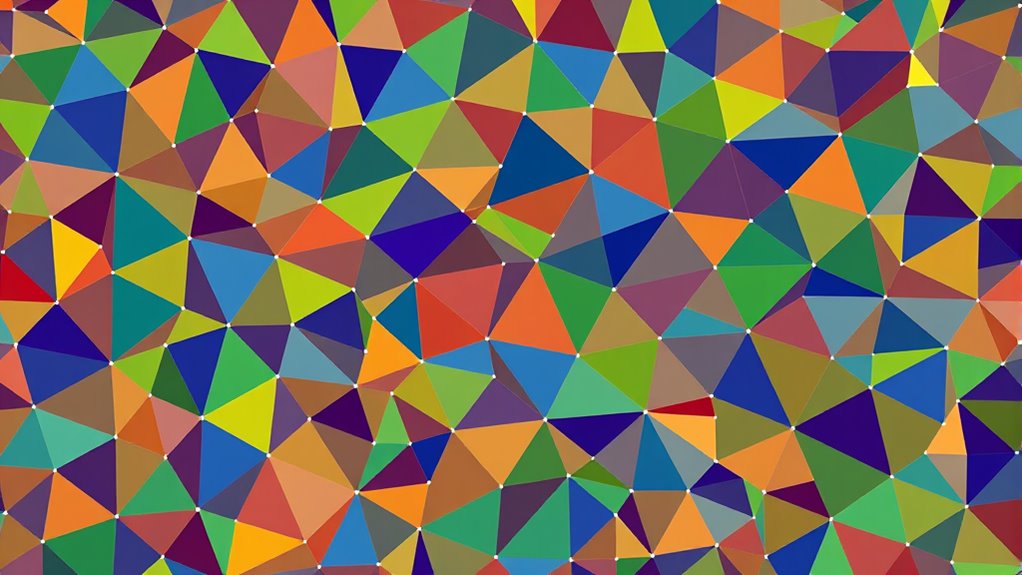Delaunay triangulation helps you connect points in a way that maximizes the smallest angles between lines, which prevents skinny or elongated triangles. This results in a mesh with high-quality, stable, and well-shaped triangles, making it ideal for accurate simulations and visualizations. It’s widely used in fields like GIS, computer graphics, and engineering because it creates efficient, reliable meshes even with complex or irregular data. Keep exploring to see how it can benefit your projects.
Key Takeaways
- Delaunay triangulation connects points to maximize the smallest angles, producing well-shaped, stable triangles.
- It guarantees no point lies inside the circumcircle of any triangle, ensuring mesh quality.
- This method reduces skinny triangles, enhancing accuracy and robustness in simulations.
- It’s widely used in finite element analysis, computer graphics, and GIS for reliable mesh generation.
- Efficient algorithms like Bowyer-Watson facilitate handling large datasets while maintaining Delaunay properties.

Have you ever wondered how to connect a set of points in a way that maximizes the smallest angles between lines? That’s where Delaunay triangulation comes into play. It’s a foundational concept in computational geometry that helps you generate a network of triangles from a given set of points, optimizing certain criteria to improve mesh quality. When working with complex shapes or spatial data, creating a mesh that avoids skinny triangles or long, thin angles is vital for accuracy and stability. Delaunay triangulation ensures that, for most cases, the triangles formed are as close to equilateral as possible, which enhances the mesh quality and reduces errors in simulations or visualizations.
Delaunay triangulation maximizes minimum angles, creating stable, high-quality meshes for accurate simulations and visualizations.
In the domain of computational geometry, the Delaunay triangulation is celebrated for its unique properties. It guarantees that no point lies inside the circumcircle of any triangle in the triangulation. This property, often called the empty circumcircle property, helps produce a mesh with well-shaped triangles. Because of this, it’s especially useful in applications like finite element analysis, where the shape of the mesh directly impacts the precision of numerical solutions. The ability to generate high-quality meshes automatically makes Delaunay triangulation a popular choice for creating meshes that are both efficient and reliable.
You’ll find that Delaunay triangulation adapts well to various datasets, whether they’re evenly spaced or irregularly distributed. It’s computationally efficient, making it suitable for large datasets where speed matters. Algorithms such as Bowyer-Watson or Fortune’s sweep line method are commonly used to compute the triangulation quickly. These algorithms incrementally add points and adjust the triangulation to maintain the Delaunay property, ensuring you get a good-quality mesh without excessive computational cost. The result is a triangulation that not only respects the geometry of your data but also enhances the overall mesh quality, which is essential for many practical applications.
Ultimately, understanding how Delaunay triangulation works helps you appreciate its significance in creating superior meshes. Its ability to maximize minimum angles between lines, reduce skinny triangles, and improve mesh quality makes it invaluable in fields like computer graphics, geographic information systems, and engineering simulations. By leveraging the principles of computational geometry behind Delaunay triangulation, you can produce meshes that are both accurate and robust, supporting better analysis and visualization of complex spatial data. Recognizing its geometric properties also helps in designing more efficient algorithms for mesh generation.
Frequently Asked Questions
How Does Delaunay Triangulation Handle Non-Convex Shapes?
You might find that Delaunay triangulation struggles with non-convex challenges, especially when shape complexity causes edges to cross or create overlapping triangles. To handle these issues, you need to preprocess the shape, like adding constraints or breaking it into convex parts before triangulating. This guarantees the triangulation accurately respects the original shape’s boundaries and maintains the benefits of Delaunay’s properties despite non-convex challenges.
Can Delaunay Triangulation Be Applied to 3D Datasets?
Absolutely, you can apply Delaunay triangulation to 3D datasets! It’s like crafting a flawless 3D mesh that captures every nuance of surface reconstruction. By extending from 2D to 3D, this method handles complex shapes and volumetric data with remarkable precision. It’s the ultimate tool for transforming scattered points into detailed, accurate models, making it indispensable for 3D modeling, computer graphics, and scientific visualization.
What Are the Limitations of Delaunay Triangulation?
You should be aware that Delaunay triangulation has limitations, especially with edge cases like collinear points or highly irregular datasets that can cause inaccuracies or ambiguities. Additionally, you might face increased computational complexity with larger datasets, which can slow down processing times. These issues mean you need to cautiously consider your dataset’s structure and size when applying Delaunay triangulation to guarantee reliable results.
How Does It Compare to Other Triangulation Methods?
You’ll find Delaunay triangulation offers superior triangulation accuracy compared to other methods, especially with irregular data points. It tends to maximize the minimum angle, avoiding skinny triangles, which improves mesh quality. While it’s computationally more complex than some simple triangulation methods, the accuracy benefits often outweigh this. If your priority is precise, high-quality triangulation, Delaunay outperforms many alternatives, making it the preferred choice despite its increased computational demands.
Are There Real-Time Applications of Delaunay Triangulation?
Yes, Delaunay triangulation is used in real-time mapping and dynamic mesh updates. You can implement it in applications like GPS navigation, where it helps update maps instantly as new data arrives. It’s also valuable in robotics for obstacle detection and environment modeling. Its ability to handle rapid changes efficiently makes it ideal for scenarios where real-time processing and continuous updates are essential.
Conclusion
In conclusion, Delaunay triangulation acts like a master builder, ensuring your points are connected ideally, much like a well-structured medieval fortress. Its properties help you analyze terrain, optimize networks, and solve spatial problems efficiently. Think of it as the Swiss Army knife of computational geometry—versatile and reliable. So, whether you’re mapping new lands or designing intricate systems, Delaunay triangulation is your trustworthy companion, guiding you through complex landscapes just like a trusty compass leading explorers of old.









